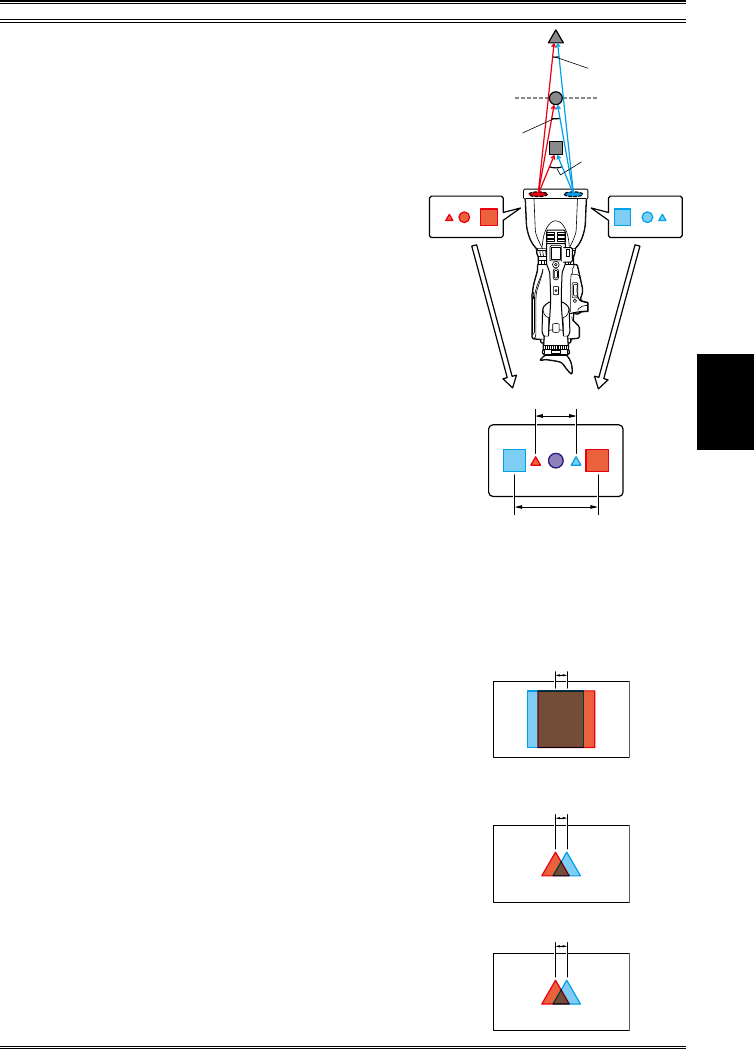
Shooting
39
What is convergence point adjustment?
What is parallax?
A human’s stereoscopic viewing takes advantage of
the brain’s ability to process information from the left
and right eyes of two images seen from their respective
perspectives. The misalignment of the two images is called
binocular parallax.
Mainly binocular parallax is used by 3D equipment to
create the feeling of stereoscopic images. When shooting,
the images from the left and right lenses are misaligned
because of the difference in the positions of the lenses
as well as in the directions of the optical axes. This
misalignment (called parallax) changes according to the
distance of the subject being shot (illustration at right).
If parallax is excessive, it is difficult to fuse the two images
within the brain. This may produce a double image, create
a feeling of strangeness, etc., causing eyestrain.
Limiting the parallax appropriately during shooting is
important for comfortable 3D viewing.
Are there guidelines for appropriate parallax?
There are two guidelines for parallax.
A Parallactic angle for pop out: 1 degree or less
A parallactic angle is produced between the left and right
lenses and the subject (illustration at right). It also changes
according to the distance of the subject being shot.
It is usually said that a parallactic angle for pop out within 1
degree is appropriate for comfortable 3D viewing.
Assuming that people view 3D images from a distance
three times the effective height of the screen, a parallactic
angle of 1 degree corresponds to misalignment of
approximately 3 % the effective width of the screen. This
leads to one of the guidelines for parallax, which is to limit
horizontal misalignment to within 3 % the effective width of
the screen.
B Parallax in depth: 50 mm or less
Parallax in depth is created when an image from the right
lens is displayed to the right and an image from the left
lens to the left on the screen.
If the value of this parallax exceeds the pupil distance of a
viewer, it will cause eyestrain.
In consideration of individual differences of viewers such
as age and pupil distance, setting parallax to within 50 mm
is preferable.
Parallax in depth is related to screen size. For a 16:9
screen, if the screen size is 77-type or less, limiting
parallax to within 3 % the effective width of the screen
means that parallax in depth will not exceed 50 mm. If the
target screen size is 103-type, limit parallax to 2.2 %. For a
200-type screen, limit parallax to 1.1 %.
How to operate this camera
The 3D guide function of this camera (Page 38) provides
a rough guide of distance ranges from the subject for
achieving appropriate parallax in two cases: for an intended
screen size of 77-type or less, and for 200-type. Referring
to the guide, change the layout of the subject or adjust the
zoom and convergence, so that the subject can be shot
within the distance range shown by the 3D guide function.
Check the parallax value (% effective screen width), using
a monitor.
•
⇒
•
⇒
•
⇒
Parallactic angle
Extreme parallax between left and
right images is demonstrated in the
illustration above.
•
Convergence point
Parallatctic
angle in depth
Left-lens image Right-lens image
Parallactic angle for pop out
Parallactic angle
in depth
Parallactic angle
for pop out
■ Parallax for pop out
Parallax: Approx. 3 % or less
(any screen size)
■ Parallax in depth
For a screen of 77-type or less
Parallax: Approx. 3 % or less
For a screen of 77-type or more
Parallax: 50 mm or less


















